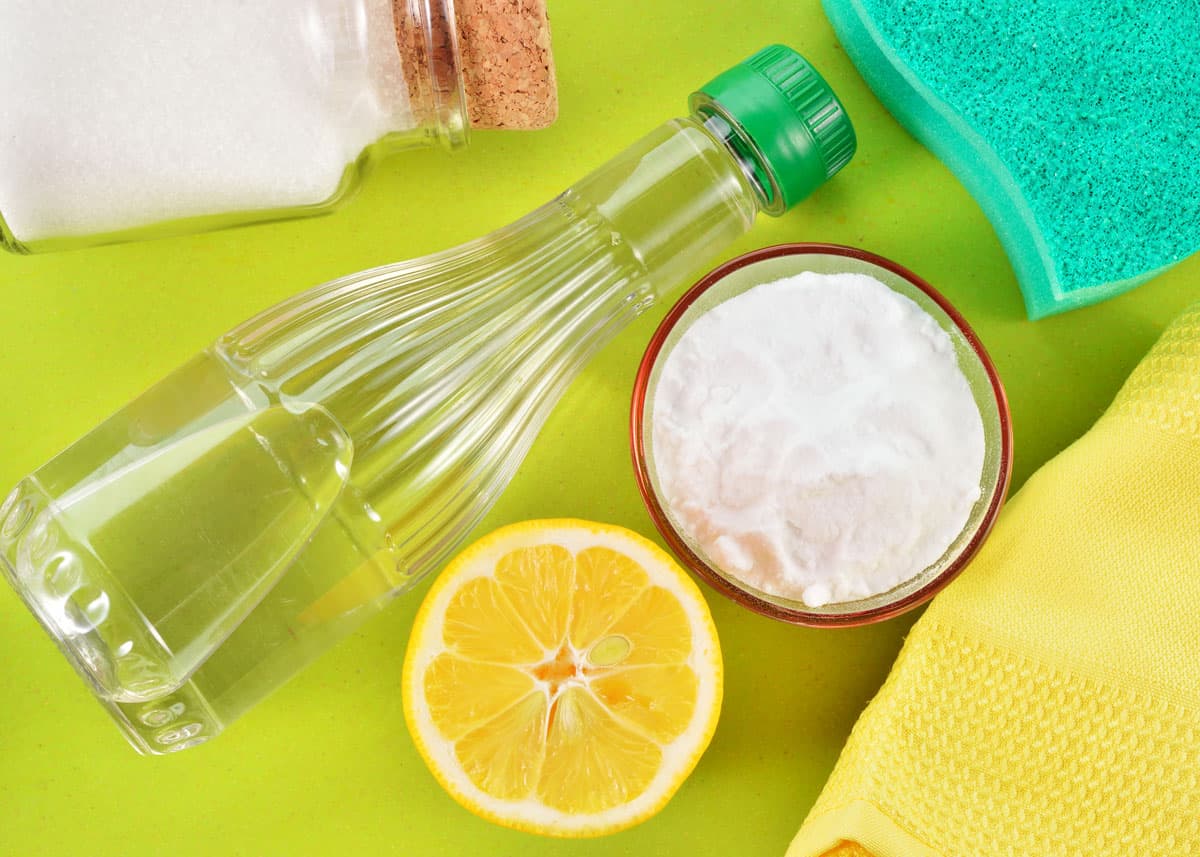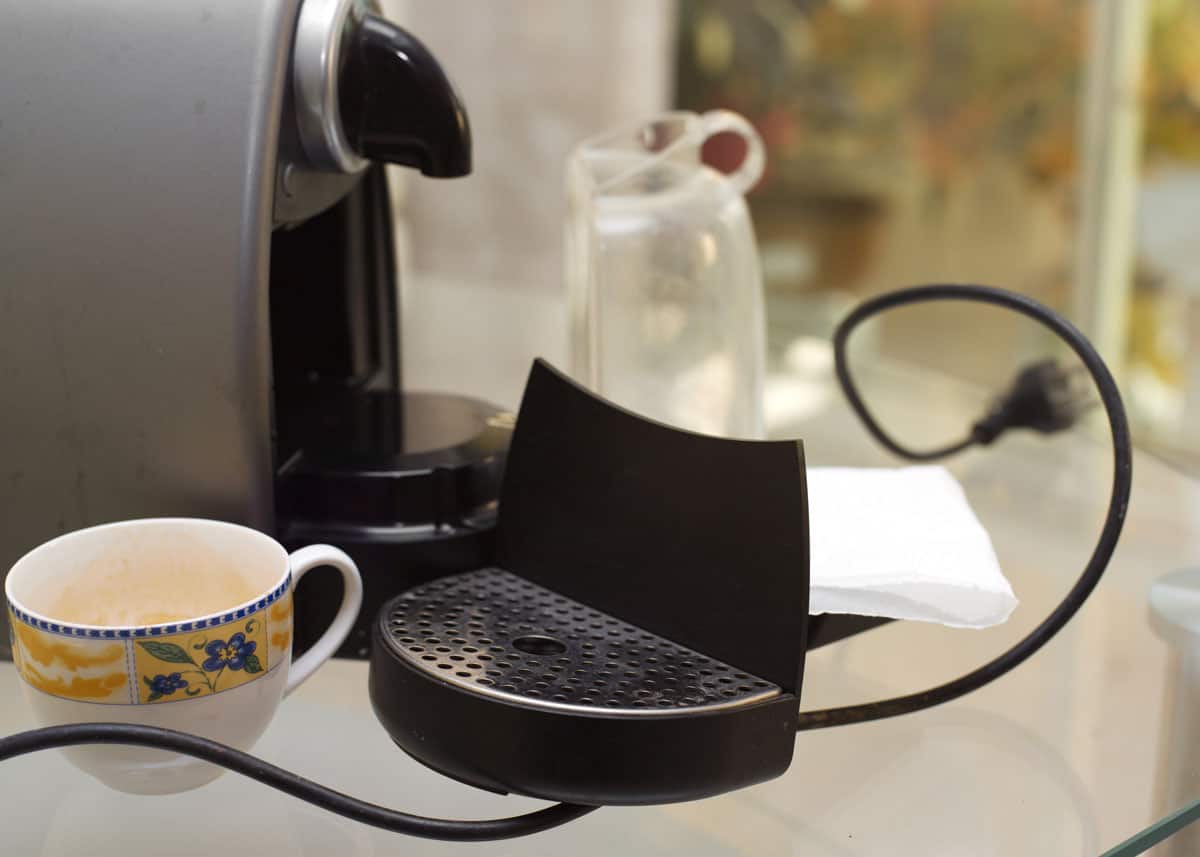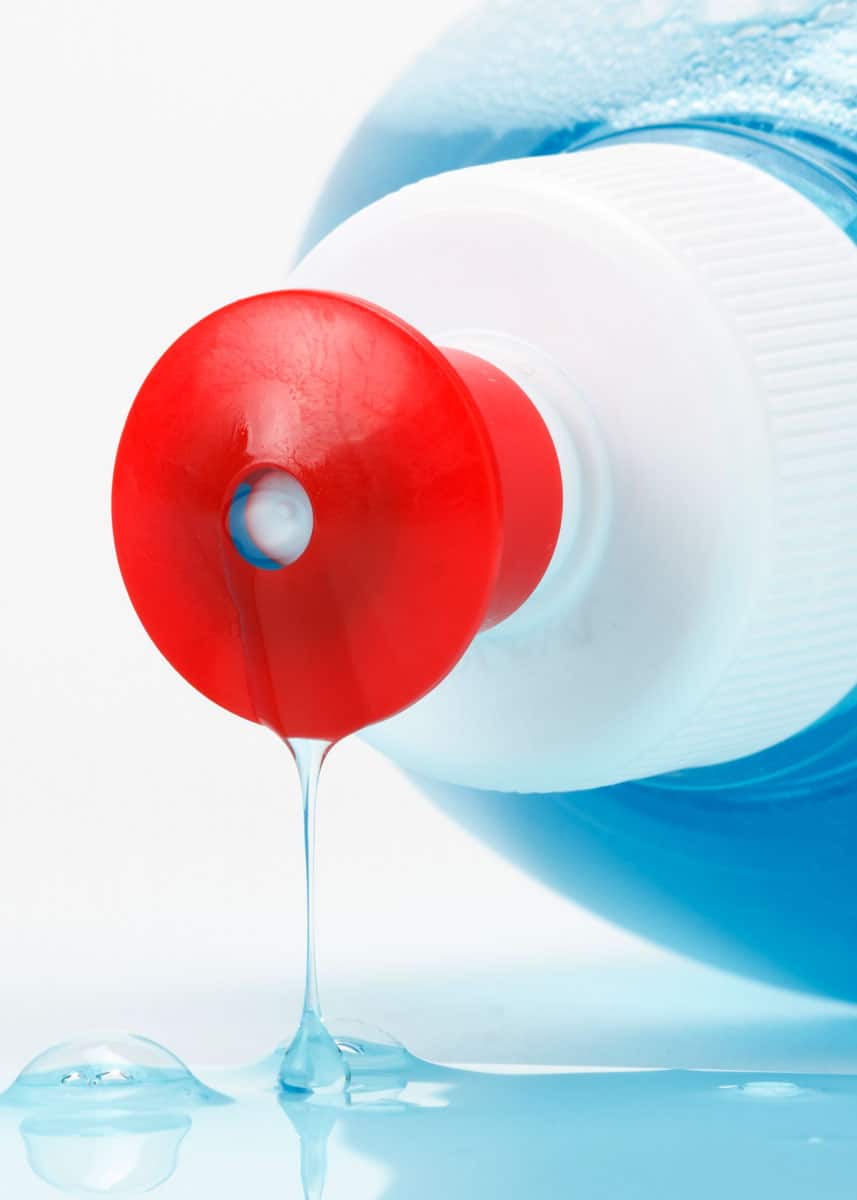Cleaning your coffee maker can be a hassle. But by using this coffee maker cleaner guide you can easily keep your maker clean and your coffee healthy (and tasting great). Includes 12 tips for quick and simple coffee pot cleaning.
Looking for specific tips for your type of maker? Check out our How to Clean a Coffee Maker Guide where we cover the ten most popular types of coffee makers.

Table of Contents
12 Tips for Cleaning a Coffee Maker
In my opinion, the best cleaning agents for coffee makers are vinegar, blue Dawn dish soap, and baking soda.
Let’s take a closer look at why I favor these cleansers.
1. What can I use to clean my coffee maker?
We don’t recommend harsh cleansers with your coffee maker because natural methods work well. They also rinse well and don’t contain harsh chemicals that can be harmful to your health.
Vinegar and baking soda are two of our standards for removing grime and killing any bacteria and mold.
- Nonabrasive scrubby pads, small brushes, and pipe cleaners are great tools for this process.
- Also, original Dawn soap is a very mild solution that is great at breaking up oils that are tough to remove.
2. How do you clean a coffee maker with baking soda?
Very gently and always mixed with water to prevent abrasions.
Baking soda is good for agitating stains on stainless steel. But you need to use a gentle touch. It’s best to use light pressure even though it may take more work/time.
Use baking soda any time you have a lingering film that doesn’t come up with just soap and water.
You can also use it to clean out some of your coffee makers that have hard-to-reach places with a brush or cleaner tool. Just make sure to rinse, rinse, rinse.
3. How do you clean a coffee maker with dish soap?
Dish soap is essential and often the first step to cleaning many coffee maker parts. But don’t run dish soap through your coffee maker. We’re talking about washing removable parts, and non-electric coffee makers with dish soap.
If you wash regularly, this may be all you need besides vinegar every once in a while.
Use a mild dish soap that doesn’t contain strong fragrances, especially with plastic parts, so that your coffee doesn’t take on the smell of the dish soap.
Again, Dawn is an excellent option because it’s gentle and doesn’t contain too much fragrance.

4. How much vinegar do you use to clean a coffee maker?
A 1:1 vinegar-to-water mixture works well.
Vinegar is an excellent sanitizer, cleaning out hard-to-reach places and killing mold and bacteria.
You can adjust the measurements as you need, with one part water and three parts vinegar being a strong solution for truly soiled machines.
Adjust the mixture as needed for maintenance cleaning.
5. How do I clean my coffee maker with apple cider vinegar?
Apple cider vinegar is an excellent alternative to white vinegar if you can’t stand the smell.
It has the same level of acidity, but the scent is milder and could prevent allergic reactions if you’re sensitive.
The downside is that it’s often more expensive than white vinegar so plan accordingly.
Also, apple cider vinegar without the mother intact is the best option so you don’t accidentally contaminate your machine trying to clean it. So either buy it without the mother or strain it out with a cheesecloth.
6. What can you use besides vinegar to clean a coffee maker?
You can always use a cleaning solution that the manufacturer makes.
Many premium coffee companies have a solution made just for their machines.
Lemon juice could also be a good alternative because of the acidity. Hot water goes a long way as well, so don’t underestimate the benefits of running a water cycle after each cycle of coffee.
7. Can I use lemon juice to clean my coffee maker?
Lemon juice could be an excellent alternative to cleaning the surfaces of your coffee maker.
There may not be enough lemon juice to run anything but a maintenance cycle, but cleaning the basket or filter parts with lemon juice could absolutely work without affecting the taste and without smelling like vinegar. Just make sure to rinse well after cleaning, as always.
8. Can you use bleach to clean a coffee maker?
We don’t recommend bleach to clean your coffee maker because it’s so difficult to get the smell and feel (or thought) of bleach out once you’ve introduced it.
If you must use bleach, dilute it as much as you possibly can and make sure to run more than enough cycles of plain water to wash out any of the bleach smell and taste. Never soak your components in bleach.

9. What does “Time to descale” the brewer mean?
Water contains minerals that can slowly clog the machine and alter the taste.
Some coffee machines alert you to this, they indicate that it’s time to remove those calcium deposits and hard water stains so that your coffee maker runs smoothly and has a better overall taste.
Don’t ignore this notification because the longer you wait, the harder it is to remove them. The best way to do this is to follow the manufacturer’s instructions for the process.
Vinegar is a great cleaner, but you may also want to buy a descale solution explicitly made for coffee machines, like this non-toxic solution by Full Circle.
10. Does a coffee maker kill bacteria?
No. The coffee maker doesn’t stay hot enough for long enough to effectively kill bacteria.
To sanitize with water the components would need to boil for five to ten minutes, so don’t rely solely on the hot water cycle to truly clean your machine.
It may flush bacteria from the coffee maker, but it’s not going to kill any colonies that have begun to form.
The only way to be sure is to follow one of the methods we’ve outlined above.

11. How do you remove calcium deposits from a coffee maker?
Removing calcium deposits is part of the descaling process. If you follow the manufacturer’s instructions, you should do a good job getting the scale off.
As you have probably noticed we recommend vinegar a lot in this post and that’s because it does such a good job of removing calcium and other deposits. But remember to check what the manufacturer recommends because your warranty could be affected if you use something other than what they say.
The longer you wait, the harder it is to do, so don’t put it off.
Some coffee makers will tell you when it’s time, but every six to eight weeks is usually suitable if your coffee maker doesn’t notify you of when it’s time.
12. How do you deep clean a coffee maker?
Deep cleaning a coffee maker can take some time, but it’s worth the effort.
Running cycles with decreasing vinegar parts to water is a great option for really getting a machine clean. If there are any removable parts, make sure to disassemble them and clean them with hot soapy water.
Follow the instruction manual for dismantling components like the steam arm on an espresso machine to get it thoroughly clean.
Finding deep cleaning videos about your specific model on YouTube can be helpful as well.
If you care for your machine regularly, including deep cleaning it, it’s always easier to keep the machine completely clean and running smoothly.

Your Turn
How do you clean your coffee machine? Did any of our tips help, or do you have any of your own to share? Please join us in the comments.
- About the Author
- Latest Posts
Dena Haines is a co-founder and blogger on EnjoyJava – and is working to make it the best coffee blog in the world.
She also blogs about travel at Storyteller.Travel and photography at Storyteller Tech. Dena is a partner at Storyteller Media, a publishing company she started with her husband, Bryan.

